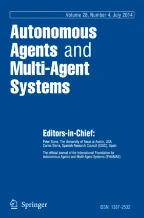Abstract
This paper studies social practices and the dynamics of their maintenance in precise mathematical and logical terms. Roughly, social practices (such shaking hands, going regularly to sauna, eating a certain kind of food at Easter, etc.) are recurrent collective activities based on collective attitudes (“shared we-attitudes”), and the central kind of social practice under study here, is one based on collective intention. Social practices are the building blocks of human societies, and also of artificial ones. In this paper, we present a mathematical model representing the dynamics of social practices, and some properties of the process are subjected to detailed mathematical study.
Similar content being viewed by others
Explore related subjects
Discover the latest articles, news and stories from top researchers in related subjects.References
A. Aulin, The Cybernetic Laws of Social Progress, Pergamon: Oxford, 1982.
W. Balzer, “A Basic Model of Social Institutions, ” Journal of Mathematical Sociology, vol. 17, pp. 1–27, 1990.
W. Balzer, Soziale Institutionen, de Gruyter: Berlin, 1993.
W. Balzer and R. Tuomela, “The structure and verification of plan-based joint intentions, ” International Journal of Cooperative Information Systems, vol. 6, pp. 3–26, 1997a.
W. Balzer and R. Tuomela, “A fixed point approach to collective attitudes, ” in Holmström-Hintikka and Tuomela, (eds.), pp. 115–142, 1997b.
W. Balzer and R. Tuomela, “Social institutions, norms, and practices, ” in Norms and Institutions in Multiagent Systems: Workshop of Agents 2000, Barcelona, 2000.
S. Blackmore, The Meme Machine, Oxford University Press: Oxford, 1999.
P. R. Cohen and H. J. Levesque, “Intention is choice with Commitment, ” AI, vol. 42, pp. 213–261, 1990.
R. Conte and C. Castelfranchi, Cognitive and Social Action, UCL: London, 1995.
F. Dignum and B. van Linder, “Modelling social agents: communication as action, ” in J. P. Müller et al. (eds.), Intelligent Agents III, Springer: Berlin, pp. 205–218, 1996.
R. Fagin, J. Y. Halpern, Y. Moses, and M. Y. Vardi, Reasoning About Knowledge, MIT Press: Cambridge, 1995.
A. Giddens, The Constitution of Society, Polity Press: Cambridge, 1984.
D. Harel, “Dynamic logic, ” in D. Gabbay and F. Guenthner (eds.), Handbook of Philosophical Logic, Vol. II, Kluwer: Dordrecht, pp. 497–604, 1984.
G. Holmström-Hintikka and R. Tuomela (eds.), Contemporary Action Theory, Vol. 2, Kluwer: Dordrecht, 1997.
G. Kavka, “The toxin puzzle, ” Analysis, vol. 43, pp. 33–36, 1983.
J. L. Mackie, The Cement of the Universe, Oxford University Press: Oxford, 1974.
Y. Moses and M. Tennenholtz, “Artificial Social Systems, ” Computers and Artificial Intelligence, vol. 14, pp. 533–562, 1995.
M. Prietula, K. Carley, and L. Gasser, (eds.), Simulating Organizations: Computational Models of Institutions and Groups, MIT Press: Cambridge MA, 1998.
A. Rao, M. P. Georgeff, and E. A. Sonenberg, “Social plans: a preliminary report, ” in E. Werner and Y. Demazeau (eds.), Decentralized A.I.-3, NorthHolland: Amsterdam, pp. 57–76, 1992.
P. Suppes, “A Probabilistic Theory of Causality, ” in Acta Philosophica Fennica, NorthHolland: Amstderdam, 1970.
R. Tuomela, The Importance of Us, Stanford University Press: Stanford, 1995.
R. Tuomela, The Philosophy of Social Practices: A Collective Acceptance View, Cambridge: Cambridge University Press, 2002.
R. Tuomela and M. Bonnevier-Tuomela, “From social imitation to teamwork, ” in Holmström-Hintikka and Tuomela (eds.), pp. 1–47, 1997.
G. Weiss (ed.), Multiagent Systems, MIT Press: Cambridge, 1999.
R. Westermann, “Festinger's theory of cognitive dissonance: a structuralist theory net, ” in, W. Balzer, C. U. Moulines, and J. D. Sneed (eds.), Structuralist Knowledge Representation: Paradigmatic Examples, Rodopi: Amsterdam, pp. 189–217, 2000.
M. Wooldridge and N. R. Jennings, “Formalizing the cooperative problem solving process, ” in Holmström-Hintikka and Tuomela (eds.), pp. 143–161, 1997.
M. Wooldridge and N. R. Jennings, “The cooperative problem-solving process, ” Journal of Logic and Computation, vol. 9, pp. 563–592, 1999.
Author information
Authors and Affiliations
Rights and permissions
About this article
Cite this article
Balzer, W., Tuomela, R. Collective Intentions and the Maintenance of Social Practices. Autonomous Agents and Multi-Agent Systems 6, 7–33 (2003). https://doi.org/10.1023/A:1021761321751
Issue Date:
DOI: https://doi.org/10.1023/A:1021761321751
